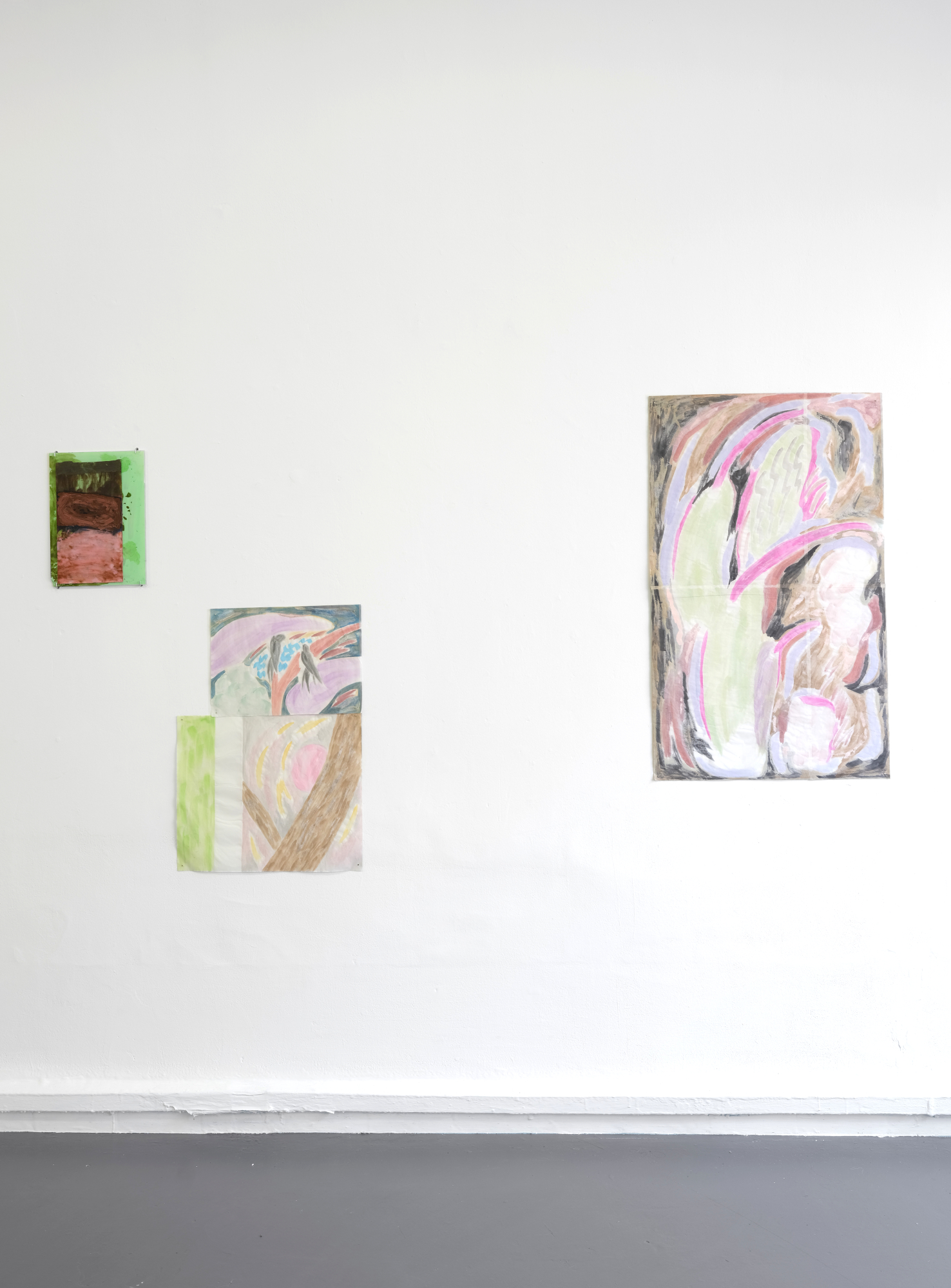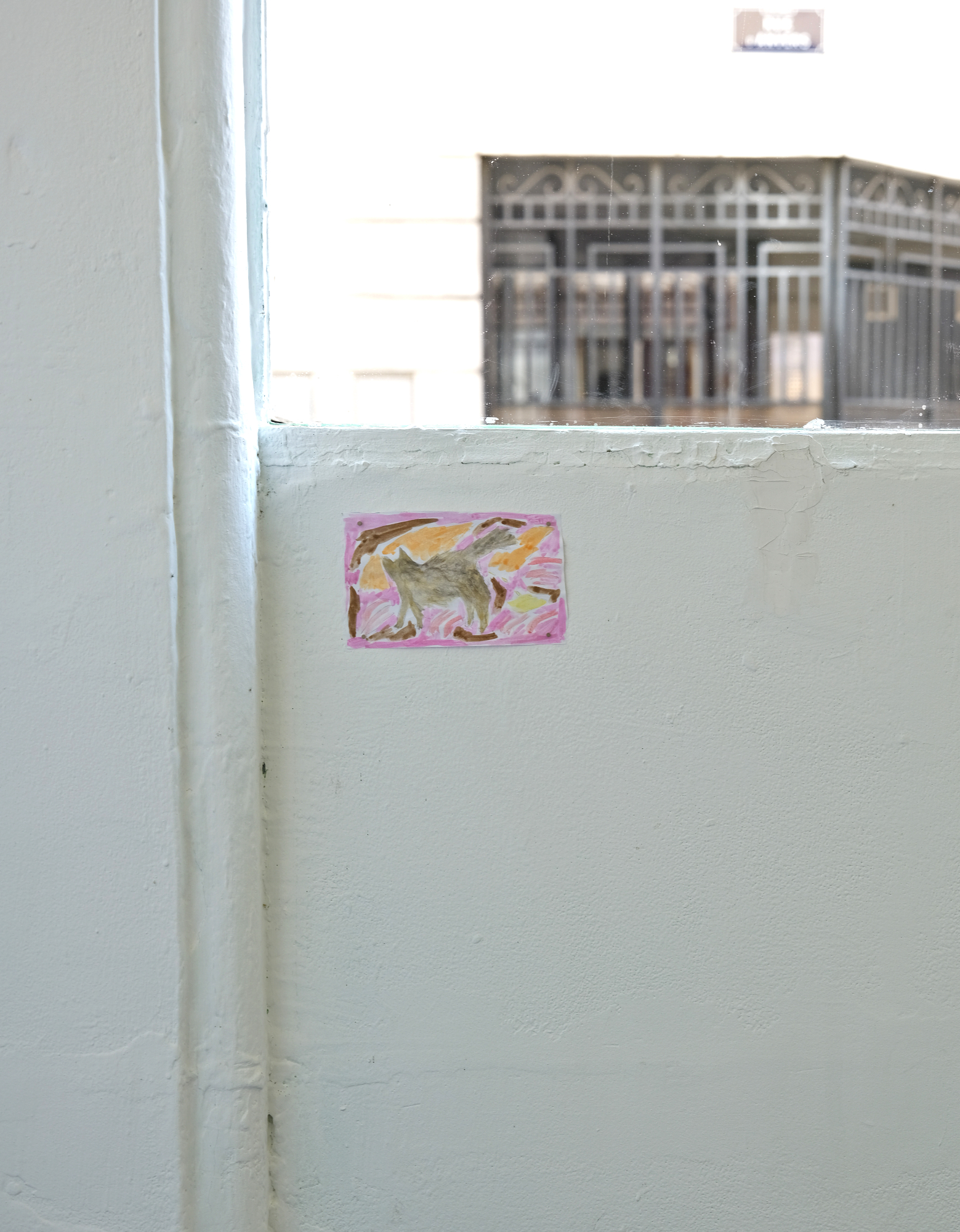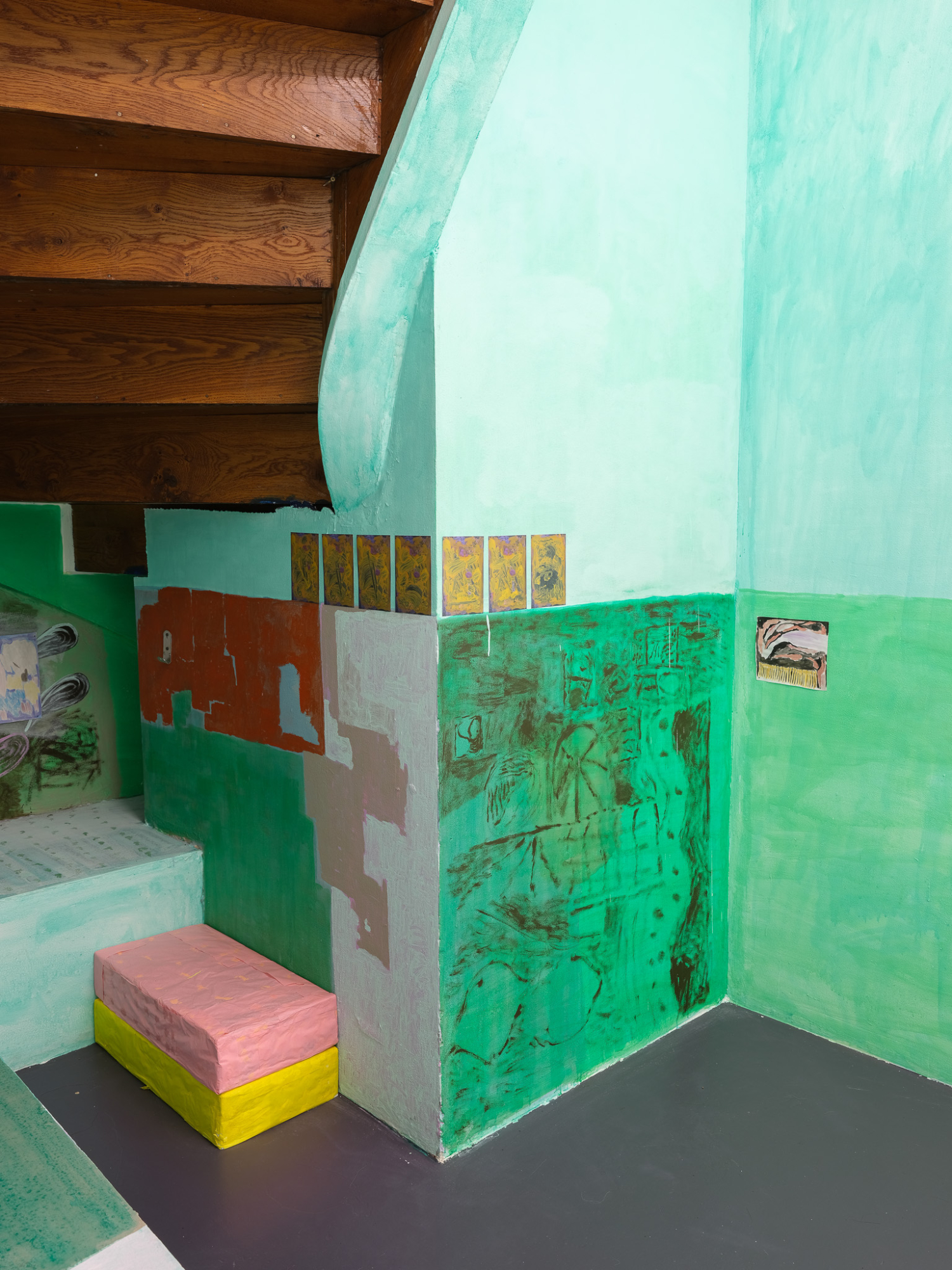“Dilettante de jour”
Romain Bobichon, Amélie Charroin
Romain Bobichon, Amélie Charroin
Exposition du 13 juin au 25 juil. 2025













[FR]
Le parfum de l’éther
Marie Canet
Amélie Charroin est designer textile. Romain Bobichon est peintre. La galerie Tator, qui développe depuis 2019 un cycle d’expositions consacré aux liens entre peinture et arts appliqués, réunit ici les deux artistes alors qu’Amélie semble de plus en plus s’émanciper du support textile — notamment par le transfert des motifs dans des livres d’artiste, et que Romain travaille à l’écriture d’une piéce poétique ayant pour sujet la couleur — une expansion de la peinture vers des choses très volatiles. Tous deux ont un penchant pour le décoratif. Celui-ci a le parfum de l’éther. Il est ancré dans les événements de la vie, les situations, les états sensibles. Il n’est donc pas uniquement du côté du visuel : il dépend du temps, de l’économie, du social.
Comme beaucoup, les deux artistes ont engagé un mouvement de décentrement après la pandémie de Covid-19. Romain Bobichon est descendu dans le Tarn afin de vivre dans un bel endroit entouré d’ami.es. Amélie Charroin, s’est installée au sud-ouest de Lyon car elle voulait de l’espace pour créer et s’occuper de son enfant. Elle a délaissé les tables sur lesquelles elle travaillait dans des ateliers partagés pour peindre à la maison, directement sur le sol, avec ce qui était à sa portée : la vie, l’imaginaire, la routine domestique... Ses supports sont principalement faits de papiers recyclés. Elle utilise notamment des gouaches en pastille achetées au rayon scolaire des supermarchés, ce qui confère une qualité singulière à sa gamme colorée.
Elle pratique ainsi la transparence et l’art de la pochade, une activité mineure et sportive de la peinture basée sur la rapidité de l’exécution plutôt que sur la perfection du rendu. Dans sa dernière série, elle peint un endroit, sorte de bulle utopique, située dans une campagne fantasmée, animée par le vent et la lumière, où l’on perçoit parfois un plan d’eau, des herbes, un animal.
Romain Bobichon a d’ailleurs toujours aimé les kitchen table artists - celleux qui travaillent à la maison et font de leur espace domestique un atelier improvisé. Il peint sur des supports mobiles, explore la transparence, l’adaptabilité des teintes et leur réfraction dans les lieux où il se produit. Il s’intéresse aux pigments — qu’ils soient minéraux, animaux, végétaux ou synthétiques — à la richesse des couleurs et aux mouvements qu’elles génèrent : leur performativité activée grâce à la lumière, un élément essentiel dans l’apparition de la couleur et de ses reflets. Dans la série de gouaches réalisées sur la vitre de son scanner, il peint à l’œuf — un matériau très accessible qui lui permet de créer des textures veloutées. Il éprouve ainsi la mutabilité de la matière, l’effet de ses gestes et les enregistre grâce à l’appareil comme s’il s’agissait d’une partition musicale.
Sur le carton d’invitation, on voit la photographie de deux insectes. Parmi les herbes, un bourdon (drone en anglais, si l’on parle d’une musique en nappe composée à partir d’un accord ou d’une note continue). A côté de lui, une guêpe coucou (une espèce envahissante ornée de couleurs bleues aux reflets métalliques également appelée guêpe-bijou). Dans cette image, on pourrait percevoir deux penchants du décoratif : l’harmonique, qui tend vers l’expression, que j’associerais à l’approche de la couleur développée par Romain Bobichon; et l’atmosphérique, un état du temps qui me semble proche du rythme et des motifs d’Amélie Charroin. La distinction est réelle et tous deux parlent d’air.
Marie Canet est commissaire d’exposition et critique d’art.
Photos © Frédéric Houvert & Chloé Pupier
[EN]
The scent of ether
Marie Canet
Amélie Charroin is a textile designer. Romain Bobichon is a painter. The Tator gallery, which since 2019 has been developing a series of exhibitions devoted to the links between painting and the applied arts, is bringing the two artists together here at a time when Amélie seems to be increasingly freeing herself from the textile medium - notably by transferring motifs into artist's books, and Romain is working on writing a poetic piece on the subject of colour - an expansion of painting towards highly volatile things. Both have a penchant for the decorative. This one has the scent of ether. It is anchored in life's events, situations and sensitive states. So it's not just about the visual: it depends on time, the economy and the social.
Like many others, the two artists embarked on a process of decentring after the Covid-19 pandemic. Romain Bobichon went down to the Tarn to live in a beautiful place surrounded by friends. Amélie Charroin moved to the south-west of Lyon because she wanted space to create and look after her child. She abandoned the tables she used to work on in shared studios to paint at home, directly on the floor, with whatever was at hand: life, imagination, domestic routine... Her supports are mainly made of recycled paper. In particular, she uses gouache pellets bought in the school aisle of supermarkets, which give a singular quality to her range of colours.
She thus practises transparency and the art of the pochade, a minor and sporting activity in painting based on speed of execution rather than perfection of rendering. In her latest series, she paints a place, a kind of utopian bubble, located in a fantasised countryside, animated by wind and light, where we sometimes perceive a body of water, grasses or an animal.
Romain Bobichon has always been a fan of kitchen table artists - those who work at home and turn their domestic space into an improvised studio. He paints on mobile supports, exploring transparency, the adaptability of colours and their refraction in the places where he works. He is interested in pigments - whether mineral, animal, vegetal or synthetic - in the richness of colours and the movements they generate: their performativity activated by light, an essential element in the appearance of colour and its reflections. In the series of gouaches produced on the glass of his scanner, he paints with egg - a very accessible material that allows him to create velvety textures. In this way, he experiences the mutability of the material and the effect of his gestures, recording them with the scanner as if they were a musical score.
The invitation card shows a photograph of two insects. Among the grasses, a bumblebee (or drone, if we're talking about sheet music composed from a continuous chord or note). Next to it, a cuckoo wasp (an invasive species decorated in blue with a metallic sheen, also known as a jewel wasp). In this image, we could perceive two decorative tendencies: the harmonic, which tends towards expression, which I would associate with the approach to colour developed by Romain Bobichon; and the atmospheric, a state of time that seems to me close to the rhythm and motifs of Amélie Charroin. The distinction is real, and both speak of air.
Marie Canet is a curator and art critic.
Photos © Frédéric Houvert & Chloé Pupier
Le parfum de l’éther
Marie Canet
Amélie Charroin est designer textile. Romain Bobichon est peintre. La galerie Tator, qui développe depuis 2019 un cycle d’expositions consacré aux liens entre peinture et arts appliqués, réunit ici les deux artistes alors qu’Amélie semble de plus en plus s’émanciper du support textile — notamment par le transfert des motifs dans des livres d’artiste, et que Romain travaille à l’écriture d’une piéce poétique ayant pour sujet la couleur — une expansion de la peinture vers des choses très volatiles. Tous deux ont un penchant pour le décoratif. Celui-ci a le parfum de l’éther. Il est ancré dans les événements de la vie, les situations, les états sensibles. Il n’est donc pas uniquement du côté du visuel : il dépend du temps, de l’économie, du social.
Comme beaucoup, les deux artistes ont engagé un mouvement de décentrement après la pandémie de Covid-19. Romain Bobichon est descendu dans le Tarn afin de vivre dans un bel endroit entouré d’ami.es. Amélie Charroin, s’est installée au sud-ouest de Lyon car elle voulait de l’espace pour créer et s’occuper de son enfant. Elle a délaissé les tables sur lesquelles elle travaillait dans des ateliers partagés pour peindre à la maison, directement sur le sol, avec ce qui était à sa portée : la vie, l’imaginaire, la routine domestique... Ses supports sont principalement faits de papiers recyclés. Elle utilise notamment des gouaches en pastille achetées au rayon scolaire des supermarchés, ce qui confère une qualité singulière à sa gamme colorée.
Elle pratique ainsi la transparence et l’art de la pochade, une activité mineure et sportive de la peinture basée sur la rapidité de l’exécution plutôt que sur la perfection du rendu. Dans sa dernière série, elle peint un endroit, sorte de bulle utopique, située dans une campagne fantasmée, animée par le vent et la lumière, où l’on perçoit parfois un plan d’eau, des herbes, un animal.
Romain Bobichon a d’ailleurs toujours aimé les kitchen table artists - celleux qui travaillent à la maison et font de leur espace domestique un atelier improvisé. Il peint sur des supports mobiles, explore la transparence, l’adaptabilité des teintes et leur réfraction dans les lieux où il se produit. Il s’intéresse aux pigments — qu’ils soient minéraux, animaux, végétaux ou synthétiques — à la richesse des couleurs et aux mouvements qu’elles génèrent : leur performativité activée grâce à la lumière, un élément essentiel dans l’apparition de la couleur et de ses reflets. Dans la série de gouaches réalisées sur la vitre de son scanner, il peint à l’œuf — un matériau très accessible qui lui permet de créer des textures veloutées. Il éprouve ainsi la mutabilité de la matière, l’effet de ses gestes et les enregistre grâce à l’appareil comme s’il s’agissait d’une partition musicale.
Sur le carton d’invitation, on voit la photographie de deux insectes. Parmi les herbes, un bourdon (drone en anglais, si l’on parle d’une musique en nappe composée à partir d’un accord ou d’une note continue). A côté de lui, une guêpe coucou (une espèce envahissante ornée de couleurs bleues aux reflets métalliques également appelée guêpe-bijou). Dans cette image, on pourrait percevoir deux penchants du décoratif : l’harmonique, qui tend vers l’expression, que j’associerais à l’approche de la couleur développée par Romain Bobichon; et l’atmosphérique, un état du temps qui me semble proche du rythme et des motifs d’Amélie Charroin. La distinction est réelle et tous deux parlent d’air.
Marie Canet est commissaire d’exposition et critique d’art.
Photos © Frédéric Houvert & Chloé Pupier
[EN]
The scent of ether
Marie Canet
Amélie Charroin is a textile designer. Romain Bobichon is a painter. The Tator gallery, which since 2019 has been developing a series of exhibitions devoted to the links between painting and the applied arts, is bringing the two artists together here at a time when Amélie seems to be increasingly freeing herself from the textile medium - notably by transferring motifs into artist's books, and Romain is working on writing a poetic piece on the subject of colour - an expansion of painting towards highly volatile things. Both have a penchant for the decorative. This one has the scent of ether. It is anchored in life's events, situations and sensitive states. So it's not just about the visual: it depends on time, the economy and the social.
Like many others, the two artists embarked on a process of decentring after the Covid-19 pandemic. Romain Bobichon went down to the Tarn to live in a beautiful place surrounded by friends. Amélie Charroin moved to the south-west of Lyon because she wanted space to create and look after her child. She abandoned the tables she used to work on in shared studios to paint at home, directly on the floor, with whatever was at hand: life, imagination, domestic routine... Her supports are mainly made of recycled paper. In particular, she uses gouache pellets bought in the school aisle of supermarkets, which give a singular quality to her range of colours.
She thus practises transparency and the art of the pochade, a minor and sporting activity in painting based on speed of execution rather than perfection of rendering. In her latest series, she paints a place, a kind of utopian bubble, located in a fantasised countryside, animated by wind and light, where we sometimes perceive a body of water, grasses or an animal.
Romain Bobichon has always been a fan of kitchen table artists - those who work at home and turn their domestic space into an improvised studio. He paints on mobile supports, exploring transparency, the adaptability of colours and their refraction in the places where he works. He is interested in pigments - whether mineral, animal, vegetal or synthetic - in the richness of colours and the movements they generate: their performativity activated by light, an essential element in the appearance of colour and its reflections. In the series of gouaches produced on the glass of his scanner, he paints with egg - a very accessible material that allows him to create velvety textures. In this way, he experiences the mutability of the material and the effect of his gestures, recording them with the scanner as if they were a musical score.
The invitation card shows a photograph of two insects. Among the grasses, a bumblebee (or drone, if we're talking about sheet music composed from a continuous chord or note). Next to it, a cuckoo wasp (an invasive species decorated in blue with a metallic sheen, also known as a jewel wasp). In this image, we could perceive two decorative tendencies: the harmonic, which tends towards expression, which I would associate with the approach to colour developed by Romain Bobichon; and the atmospheric, a state of time that seems to me close to the rhythm and motifs of Amélie Charroin. The distinction is real, and both speak of air.
Marie Canet is a curator and art critic.
Photos © Frédéric Houvert & Chloé Pupier